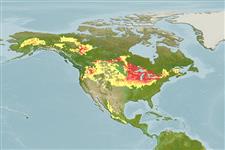Classificação / Names
Nomes comuns | Sinónimos | Catalog of Fishes (gen., sp.) | ITIS | CoL | WoRMS | Cloffa
Actinopterygii (peixes com raios nas barbatanas) >
Perciformes (Perch-likes) >
Percidae (Perches) > Luciopercinae
Etymology: vitreus: vitrea meaning glassy, alluding to the nature of the large, silvery eyes (Ref. 1998).
Ambiente / Clima / Intervalo
Ecologia
; Água doce; estuarina demersal; potamódromo (Ref. 51243); intervalo de profundidade ? - 27 m (Ref. 11002). Temperate; ? - 29°C (Ref. 12741), preferred ?; 55°N - 35°N
North America: St. Lawrence-Great Lakes, Arctic, and Mississippi River basins from Quebec to Northwest Territories in Canada, south to Alabama and Arkansas in the USA. Widely introduced elsewhere in the USA, including Atlantic, Gulf, and Pacific drainages. Rarely found in brackish waters of North America (Ref. 1998).
Length at first maturity / Tamanho / Peso / Idade
Maturity: Lm ?, range 36 - ? cm
Max length : 107 cm FL macho/indeterminado; (Ref. 1998); common length : 54.0 cm TL macho/indeterminado; (Ref. 12193); Peso máx. publicado: 11.3 kg (Ref. 4699); Idade máx. registada: 29 anos (Ref. 12193)
Espinhos dorsais (total): 13 - 17; Raios dorsais moles (total): 18-22; Espinhos anais 2; Raios anais moles: 11 - 14; Vértebras: 44 - 48. Nuptial tubercles absent. Differentiation of sexes difficult. Branchiostegal rays 7,7 or 7,8 (Ref. 1998).
Occurs in lakes, pools, backwaters, and runs of medium to large rivers. Prefers large, shallow lakes with high turbidity (Ref. 9988, 10294). Feeds at night, mainly on insects and fishes (prefers yellow perch and freshwater drum but will take any fish available) but feeds on crayfish, snails, frogs, mudpuppies, and small mammals when fish and insects are scarce (Ref. 1998). Although not widely farmed commercially for consumption, large numbers are hatched and raised for stocking lakes for game fishing (Ref. 9988). Utilized fresh or frozen; eaten pan-fried, broiled, microwaved and baked (Ref. 9988).
Spawning occurs in small groups (a larger female and two smaller males or two females and up to six males) that engage in chasing, circular swimming, and fin erection. The group then ascends to shallow water, females roll on their side, and eggs and sperm are released. Deposition of eggs usually occurs in a single night (Ref. 1998). Larvae pelagic (Ref. 7471).
Robins, C.R., R.M. Bailey, C.E. Bond, J.R. Brooker, E.A. Lachner, R.N. Lea and W.B. Scott, 1991. Common and scientific names of fishes from the United States and Canada. Am. Fish. Soc. Spec. Pub. (20):183 p. (Ref. 3814)
Categoria na Lista Vermelha da IUCN (Ref. 115185)
CITES (Ref. 94142)
Not Evaluated
Ameaça para o homem
Harmless
Utilização humana
Pescarias: espécies comerciais; Aquacultura: experimental; peixe desportivo: sim; Aquário: Aquários públicos
Ferramentas
Relatórios especiais
Descarregue XML
Fontes da internet
